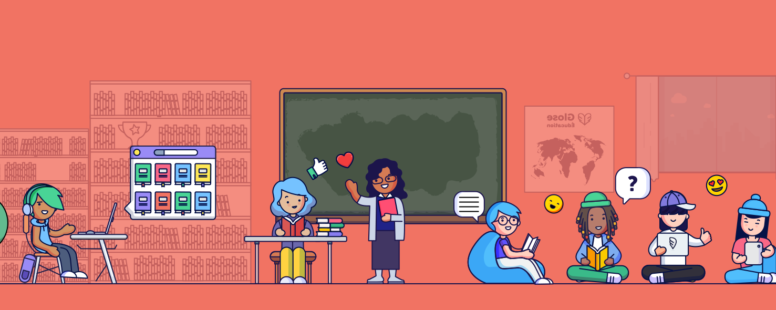Redefining Back-to-School Planning for ELA Teachers
Christophe Spy/ July 21, 2020/ Back to School, Professional Learning Communities, Teacher Tips/ 0 comments
Seven Ways to Make the Most of this Back-To-School Season
This time last year, schools engaged in minute-by-minute routine and procedure planning, building procedures, communications, curriculum training, and even epi-pen practice in the health room were in full swing as teachers prepared to welcome students back into buildings. In my world, ELA teachers built up baskets of books grouped by genres in libraries and placed bean bag chairs and lap desks lined up with ipads and headphones in reading corners. Back-to-school packets and supply baskets adorned desks that were puzzled together to facilitate turn-and-talk experiences.
It’s a routine familiar to virtually all teachers; many of us welcome that familiarity and find the whole process energizing. This year, however, our back-to-school planning is as daunting as it is anything else. Simply stated, planning for back to school will be unlike anything we’ve ever done before. The 2020-2021 school year will require teachers to rethink and refine tried-and-true practices so they can be done even better. There’s no group of professionals better qualified to handle even the most difficult of circumstances. In fact, what we’re finding now is that this ‘new normal’ is fast becoming a catalyst for redefining how we can successfully start the school year. Here are seven things that we as teachers, coaches, and school leaders can do to make the most of this back-to-school season.
1. Cultivate Healthy Relationships
First and foremost, our resilience will rely heavily on prioritizing relationship building with students, families, and fellow staff members. Youki Terada encourages teachers to focus on relationships first when establishing a safe classroom environment in the article “Covid-19’s Impact on K-12 Students’ Academic and Mental Well-Being”, Terada explains, ”teachers can act as a powerful buffer against the adverse effects of trauma by helping to establish a safe and supportive environment for learning.” We have to take time to plan out routines for relationship building so that our students will feel comfortable in our classrooms – online and in-person.
Some ways to build relationships while behind a screen or in full PPE are very similar to the strategies we’ve previously used during the first months of school. We can greet students as they enter the classroom or when they’ve logged onto the learning platform. As students trickle in, you can make conversation about non-academic topics such as favorite music groups and sports icons. Take extra time to learn how to pronounce all names correctly and use those names repeatedly throughout class. Ice breakers for engaging students to interact with each other can still be done in breakout rooms or gallery walks.
As teachers and leaders, we’ve got to be cognizant of showing others that they are seen and valued, so what we’ve relied on before has to be amplified to make a stronger impact. Content and curriculum will take a backseat to relationship building so teachers can create a strong foundation that will support students through whatever changes come our way.
In the context of ELA teaching and learning, using a shared reading experience is not only feasible, it’s highly engaging. As students reply to teacher writing prompts, share their reactions to the text with other students, and even respond to fellow readers, relationships deepen. I can’t overstate the importance of using any and every means available to form relationships, even in a virtual setting.
2. Clarity Around “Musts”
Now, more than ever, it is critical to be crystal clear on what student learning looks like. By using the end-of-year formative assessments to backwards plan into standards-aligned lessons, teachers will become better aware of which lessons are necessary in sweating the small stuff for differentiation purposes, and which parts don’t need as much allotted time.
Teacher Leaders at Windsor Park Elementary, a school within the Charlotte-Mecklenburg School district in North Carolina, are undergoing weekly training to create exemplary formative assessments, which they then align to daily lesson plans. Through the practice of internalizing assessments, teachers are focused on exactly what must be taught in order for students to reach mastery. These leaders are amplifying the ‘must learns’ of the lesson and now able to hyperfocus on what matters most in uplifting students to success, and therefore are more efficient in lesson delivery.
Compared to in-person instruction, when learning online there are more obstacles around teaching ‘bell to bell’. Before you can start a lesson, you have to wait for all students to log on. When accessing materials in hyperlinks, folders, and through technological difficulties, time is continually taken away from learning. By having a laser-like focus on the most important parts of the lesson, teachers are able to maximize the time they have in front of their students and not have to stress at all of the things shaving off time.
3. Classroom Structure
As schools roll out a variety of ways to facilitate learning, classroom structure is evolving. Classrooms are the base of comfort, learning, and relationship building. Here at Glose, classrooms are redefined. We have an online platform that provides the best books for learners, while reading is made social and rewarding. Anywhere, anytime, teachers and leaders can upload their own text for shared content and create reading groups with over a million shared texts. Just because paper books aren’t sanitary and readily available from homes doesn’t mean that carefully curated bookshelves and partner reading opportunities aren’t accessible. We have to rethink reading practices and how they shape our classrooms.
First and foremost, teachers will need to cultivate a common space for reading and collaborating about texts. The right kind of ebook platform will allow teachers to see what ‘just right’ books students are reading and track their completion rate while engaging students in learning through a social media platform. In the case of Glose for Education, teachers can upload content right into e-books for students to use. Students can then highlight, react to, and comment their annotations right into the margins. Navigating different folders, online learning platforms, and the myriad of ways to distribute and collect learning tasks has been overwhelming for families, which is why ELA classrooms can and should leverage ebook platforms to help create effective classroom structures
4. Concise Collaboration within our PLC’s
When schools began to shutter their doors, schools moved more than teaching and learning online, they moved the entire educational apparatus into the virtual space. This includes planning, administration, logistics, and the critically important Professional Learning Communities (PLCs). While trying to keep the practices of PLC collaboration and accountability alive, conversations quickly turned from problem-solving to problem-naming. How could you plan for the future when you aren’t even sure what is happening right now?
Having made it through the school year, teachers now have practice in the impracticable, which means PLC’s are ready to begin more strategic collaborative work. In “Professional Learning Communities: Building Blocks for School Culture and Student Learning”, Milbrey McLaughlin and Joan Talbert discuss their studies of PLC’s on student learning. researchers discovered that PLC’s with strong collaborative practices centered on student data result in higher growth of student learning. McLaughlin and Talbert recognized the qualities of a strong PLC relied on their communal ability to determine learning objectives, analyze student work samples to identify gaps, and share ways to work together in addressing those gaps.
Also, book studies can be powerful tools for developing the teacher expertise necessary for improving performance and enhancing student learning through deliberate practice. What sets an effective book study apart from an ineffective one lies in both the initial planning of the book study itself and the utilization of the knowledge, skills and practices acquired. English Language Arts teachers can utilize ebook platforms to redefine the practice of a successful PLC. Working together, teachers can overcome obstacles in an online world of lesson design, delivery, and assessment of student work. As a result, collective teacher efficacy will increase, leading to more effective and confident Professional Learning Communities. As teachers sharpen skills at the beginning of this year, reliance on PLC is fundamental in creating large gains in teacher practice and student learning.
5. Celebrate Any and All Wins
While redefining school, it is very easy to get bogged down with all of the details to work through and figure out. In doing so, teachers can begin to feel the weight of the responsibility, which feels like an uphill battle. Teachers must determine easy wins as they open the year, and celebrate the heck out of them when they happen.
For example, setting a goal to celebrate the first time all of the students have completed the first book read online or celebrating students when they keep their face coverings on during independent reading time can build momentum that can be leveraged throughout the year.
6. Caring for Self
With all of the focus on providing extra support for students that may be in precarious situations as a result of blended learning opportunities, self care for teachers has often become lost among the minute details in reopening plans. Stakeholders are making sure students are getting what they need to feel safe and loved in the journey of becoming college and career ready. Unfortunately, the shared urgency may lead teachers in feeling the need to make even more sacrifices of their own selves as they focus on caring for their students.
In response to the need for self-care of educators, WestEd created the brief “Self-Care Strategies For Educators During Coronavirus Crisis: Supporting Personal Social and Emotional Well-Being” which includes 30 strategies to help teachers focus on wellbeing while they work on the frontlines. As teachers return this year, top of mind is to be realistic with oneself by creating a new baseline of what normal can be. What was normal may be lightyears away from where we are now. Couple the new expectations with strategically reducing the workload for both teachers and students so that teachers can prevent overload and burnout.
7. Count on Learning From Last Year
This year is one for the history books. Even if schools do not feel prepared for what is on the horizon, we must lean in on each other to share successes and learn from shared struggles. As a teaching force facing this upcoming year, there are only the cliches to describe why back-to-school planning must be redefined. We are in uncharted territory due to the unprecedented times and need to create a new normal. And we all know this year will be anything but normal!

About the Author
Samantha Reichard serves as Lead Real Time Teacher Coach for Center City 1 Learning Community in Charlotte, NC, serving as a mission-critical resource for 29 inner-city and Title I schools in the Charlotte Mecklenburg School District. After graduating from the State University of New York at Fredonia, Samantha began her teaching career at East Union Middle School in Union County, NC as an eighth-grade English language arts teacher. After two years, she moved to Charlotte, NC and served as a sixth- and seventh-grade language arts teacher for five years before becoming a multi-classroom leader and real-time teacher coach. Following that, she worked on expanding the model of Multi-Classroom Leader and Real-Time Teacher Coaching (RTTC) for four years at Ranson IB Middle School.
